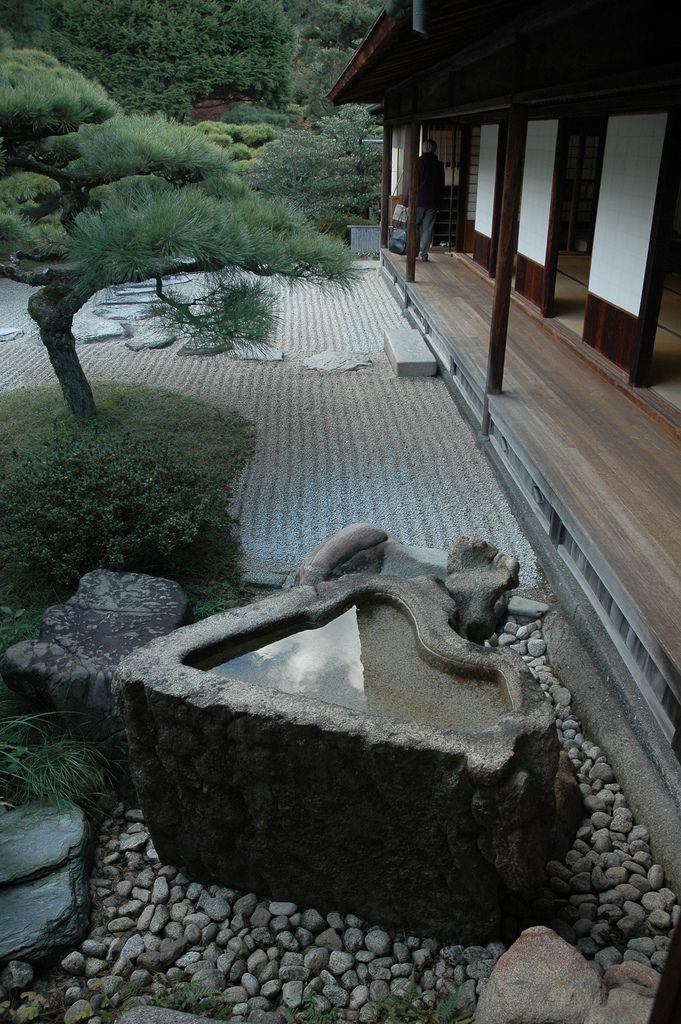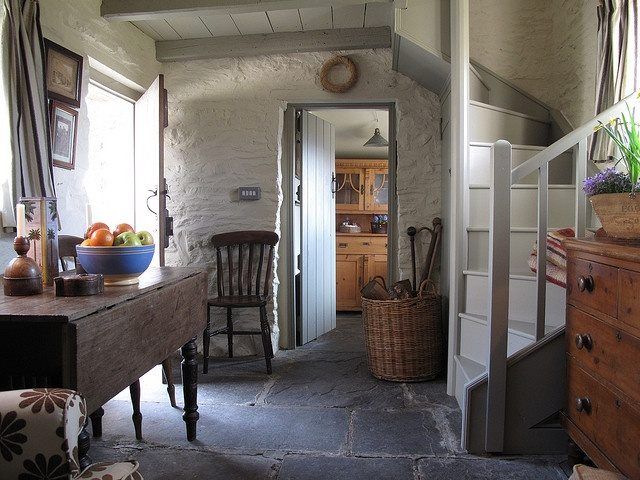Designing a zen garden
Zen Garden Ideas: How to Create Your Own Zen Garden
How to design a space for quiet contemplation with your own backyard Zen garden By Janet Loughrey, Garden Writer & Photographer
Photo by: Guadalupe Polito.
For many people, their yard is a refuge from the outside world, where they can unwind after a hard day’s work. This concept can be expanded upon to create a dedicated space for quiet contemplation. Zen gardens were originally developed by Japanese Buddhist monks as places for meditation. Aspects of Zen design can be incorporated into any home landscape.
WHAT IS A ZEN GARDEN?
A traditional Zen garden, known as karesansui, is a minimalist dry landscape comprised of natural elements of rock, gravel, sand and wood, with very few plants and no water. Man-made components include bridges, statuary and stone lanterns, with an enclosing wall or fence to separate the space from the outside world. Since the focus is on hardscaping, there is little seasonal change and the garden has year-round appeal.
Explore more landscape design styles.
The basic tenets of Zen gardening can be tailored to suit your own tastes and style. Here’s how to get started on designing your own garden space using Zen principles.
HOW TO MAKE A ZEN GARDEN
Outdoor meditation room with bench and statuary surrounded by plantings. Photo: Janet Loughrey.
Pick a site.
What part of the yard would be suited to a meditation space? How big will it be? Choose a flat, out-of-the-way corner or narrow side yard that is suitable to build a comfortable area to meditate. Make preliminary measurements to help visualize the finished room.
Do your homework.
To get ideas for how you want your space to look, peruse various resources such as the internet, books, and visit local gardens with Zen spaces. Make an idea board or wish list of attributes you want to include.
Use guiding principles.
Zen gardens are structured around seven guiding principles: Austerity (Koko), Simplicity (Kanso), Naturalness (Shinzen), Asymmetry (Fukinsei), Mystery or Subtlety (Yugen), Magical or Unconventional (Datsuzoku) and Stillness (Seijaku).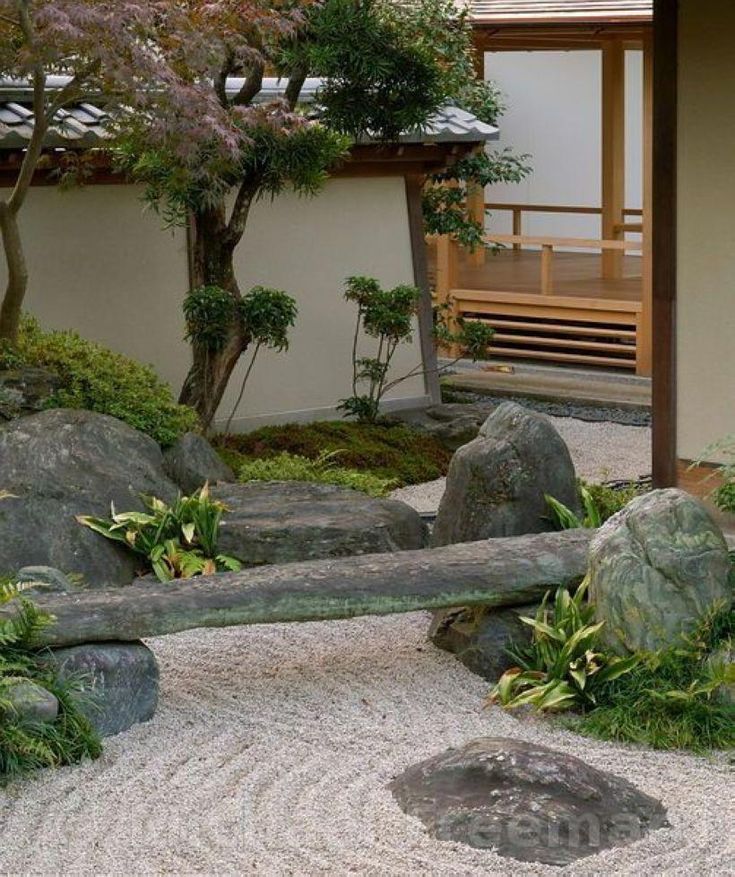 Your Zen garden should promote most or all of these concepts.
Your Zen garden should promote most or all of these concepts.
Draw a design.
Create a rough sketch to visualize your finished space. For a more elaborate project, you may want to consult a professional landscape designer. If you are using larger rocks, it’s important to know ahead of time where to site them since they are a challenge to lift and set into place.
Be flexible.
Though authentic Zen gardens have few plants and no water features, there are many variations in Zen design where water and plants can play a more prominent role. Don’t be afraid to experiment with different looks.
Make it inviting.
Choose aspects of Zen gardening that please you the most and tailor the garden to suit your tastes. Create a space that you will look forward to spending time in.
Consider scale.
Use materials that are in scale with the size of the garden room as well as the rest of your yard. Bigger stones can easily overwhelm a small space, while small rocks can get lost in a more sweeping landscape.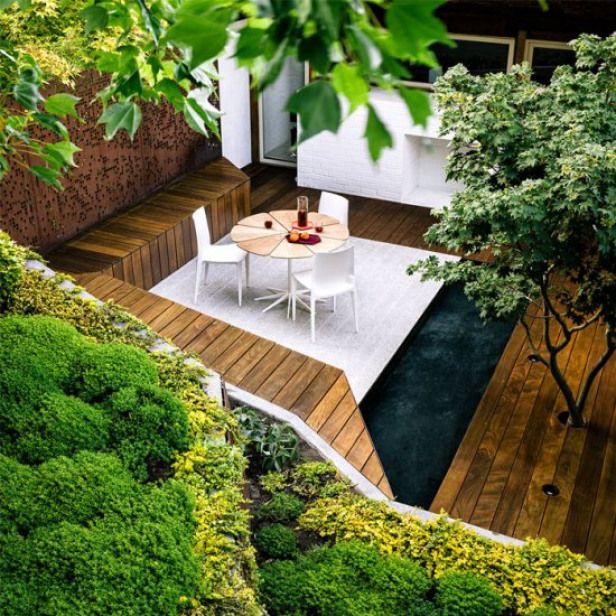
Keep it simple.
A Zen space should be simple and uncluttered, which will elicit a feeling of calm. Use a muted color scheme to relax the mind and create a soothing environment.
ZEN GARDEN ELEMENTS
Individual elements hold deep symbolic meaning. Sand or gravel raked into patterns represents water, while larger rocks suggest islands, mountains, animals, or natural elements such as fire and earth. The emphasis on abstract concepts is intended to spur the imagination and allow the mind to wander, a crucial part of the meditative process. A Zen garden should afford quiet, privacy, and aesthetic beauty.
Include at least some of these primary features which characterize a traditional Zen garden.
Rocks.
These are one of the most important components of Japanese design, as they represent the human desire for eternity and enduring elements in nature. Choosing and siting larger rocks is crucial to a cohesive Zen design. Larger rocks, which act as sculptural elements, should be installed first since they are the heaviest material and are the primary focus.
Larger rocks, which act as sculptural elements, should be installed first since they are the heaviest material and are the primary focus.
Raked gravel. Photo: Janet Loughrey.
Gravel.
Gravel is an integral part of Zen gardens, with raked patterns having symbolic meaning. During the early and late part of the day, the low angle of the sun highlights the texture and patterns of the gravel, creating an ever-changing scene that’s visually engaging. The act of raking gravel is part of the meditative process and an acquired skill that helps improve mental concentration.
Though sand can be used, gravel is more durable and easier to maintain. Use finely crushed gravel, pea gravel or small smooth pebbles which will be easy to rake into patterns. Light neutral colors of white, cream or grey are most typically used.
Patterns drawn in the gravel are used to signify a season or evoke a certain mood. Lines around larger rocks simulate water ripples, while wavy lines are reminiscent of a meandering stream.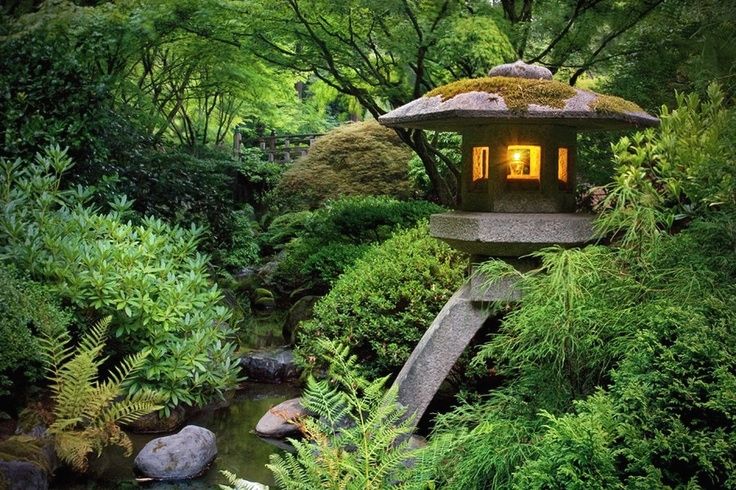 A straight line design can invoke serenity, leading the eye through the landscape or simulating a frozen winter scene.
A straight line design can invoke serenity, leading the eye through the landscape or simulating a frozen winter scene.
Use a fine-toothed metal rake to smooth the gravel, then a specially designed, wide-toothed rake to draw the pattern.
Screening.
To create a secluded garden room, enclose the area with a wall, fencing, bamboo screening, lattice panels or formal hedging.
Budha statue. Photo: Janet Loughrey.
Statuary.
A statue can serve as inspiration for meditation and become a major focal point. These typically include Buddha figurines or Japanese lanterns. Place in a prominent place in the garden.
Pathway.
A pathway can lead visitors into the garden or be placed through the gravel area to make it more accessible to maintain. Choose materials that will contrast with the larger rocks and gravel, such as darker colored stepping stones. Consider the placement of the pathway in relation to how it will affect your experience of the garden.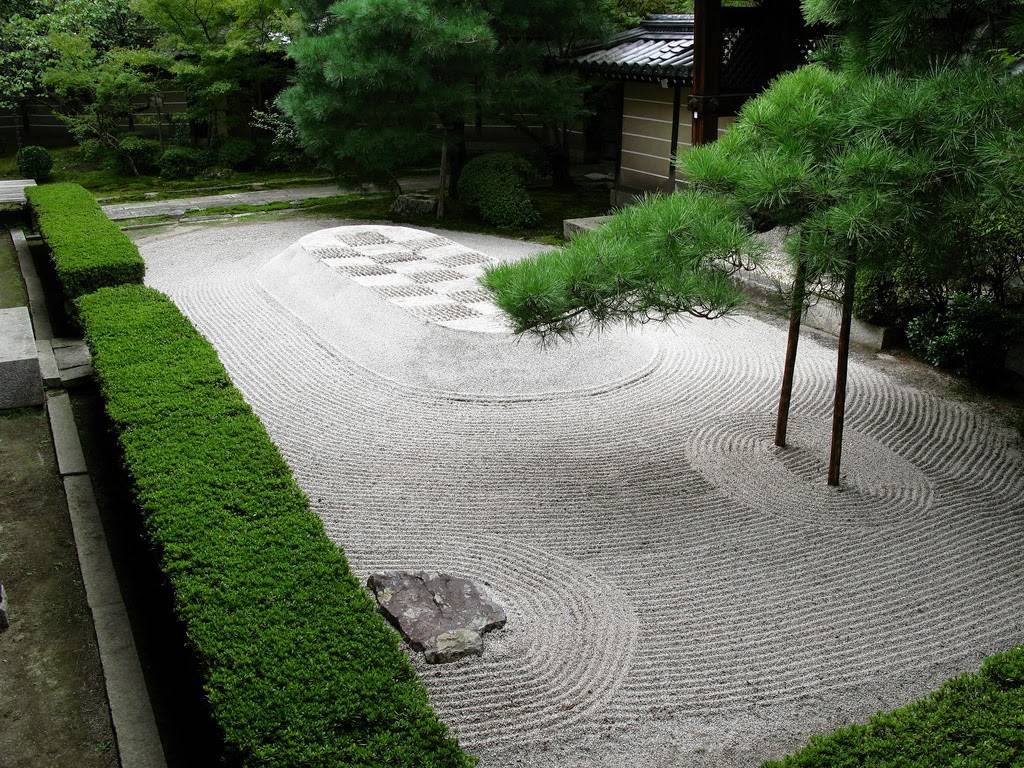 Does it lead the eye through the space, or does it draw attention to particular features? A straight pathway looks more formal, while a meandering path creates stopping points along the way to linger and observe.
Does it lead the eye through the space, or does it draw attention to particular features? A straight pathway looks more formal, while a meandering path creates stopping points along the way to linger and observe.
Seating.
Zen gardens are meant to be viewed from a particular vantage point. Place a stone bench or comfortable chair in a spot where you can most enjoy the garden.
Water.
Though water is not part of a traditional Zen garden, the sound of moving water can create a more soothing environment that is conducive to meditation. A trickling Asian-style fountain or waterfall will help drown out urban noise.
Stone pagoda lantern. Gardener: David Best. Designers: Barbara Hilty and Adriana Berry. Photo: Janet Loughrey.
Lighting.
An often overlooked aspect of home landscaping, lighting adds aesthetic appeal and allows for time spent outdoors during the evenings. Illuminate pathways, statuary, or uplight trees.
Plants.
While Zen gardens typically use few plants, you can tailor this aspect to your own tastes and style.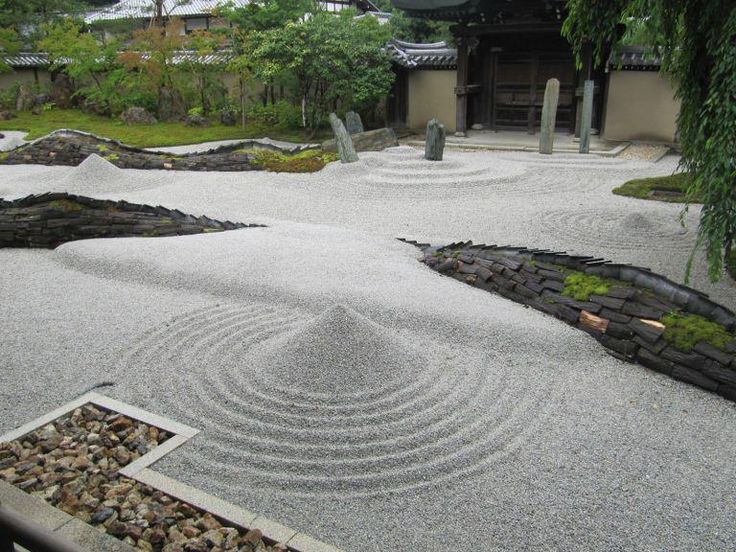 The type of plants used in Zen gardens tend to be low and creeping to complement rather than overwhelm the hardscaping. Flowers are sparse or non-existent, while foliage should be in neutral shades of green to evoke serenity and harmony. The best plants for a Zen garden include bonsai, topiaries, dwarf conifers, Japanese maples, azaleas, bamboo, sedges, creeping ground covers, ferns and mosses. The amount of light your space receives will determine whether sun or shade lovers will work best.
The type of plants used in Zen gardens tend to be low and creeping to complement rather than overwhelm the hardscaping. Flowers are sparse or non-existent, while foliage should be in neutral shades of green to evoke serenity and harmony. The best plants for a Zen garden include bonsai, topiaries, dwarf conifers, Japanese maples, azaleas, bamboo, sedges, creeping ground covers, ferns and mosses. The amount of light your space receives will determine whether sun or shade lovers will work best.
HOW TO MAINTAIN A ZEN GARDEN
Despite its austere appearance, a Zen garden requires regular maintenance to look its best. Caring for the garden is considered an important part of the meditative process.
Rake gravel.
Regular raking will help to keep patterns crisp and the gravel looking fresh.
Pick up leaves.
To keep the garden looking neat, regularly pick out or rake fallen leaves from the gravel and clean up any loose debris around stones and statuary.
Weed.
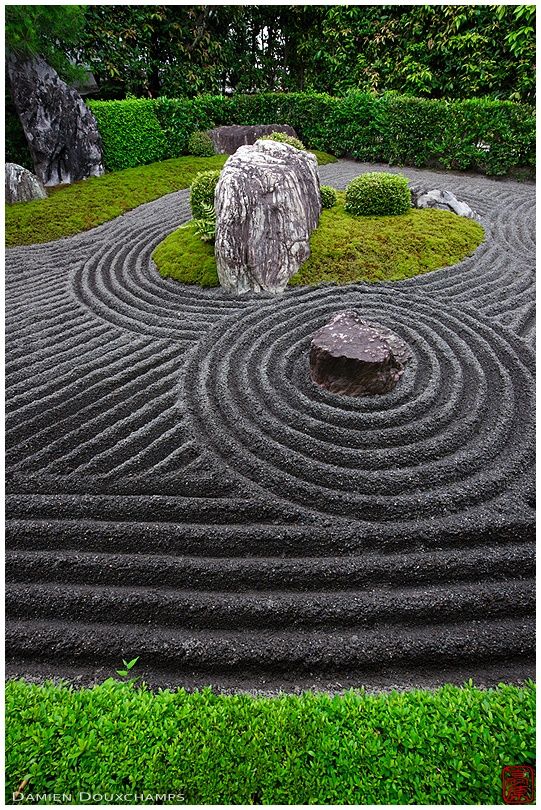
Keep gravel and planting areas free of weeds. This will be a more regular task during summer when weeds are more prolific, with little or no weeding necessary during colder months.
Prune.
Keep plants pruned to maintain a neat look. Shrubs can be kept sheared or shaped into topiaries. Cut out dead branches or growth as needed, and remove spent flowers. Trim creeping groundcovers away from gravel areas.
RELATED:
Find Your Garden Style
Rock Garden Design
Hillside Landscaping Ideas
Moon Garden Design
Seattle Zen Front Yard
Zen garden ideas: 11 ways to create a calming, Japanese-inspired landscape
(Image credit: Digital-Fotofusion Gallery/Alamy Stock Photo/Alamy)
It's no surprise that Zen garden ideas are so popular. They're gorgeous, they're simple, and they're low-maintenance. Plus, as far as garden designs go, they're a surefire way to make your outdoor space feel calm. And isn't that something we all want, to some degree?
Originating from Japan many hundreds of years ago, Zen gardens were traditionally created as places for monks to reflect on the Buddha's teachings. To encourage contemplation and feelings of peace, they were designed to be minimal spaces, devoid of distractions.
To encourage contemplation and feelings of peace, they were designed to be minimal spaces, devoid of distractions.
Billowing borders in eye-catching colors may be the stalwarts of other garden design ideas, but Zen gardens follow a more simplistic approach. Often, carefully positioned rocks and pebbles are the stars of the show in these peaceful Japanese garden ideas. Planting is kept to a minimum, or at least to a minimal palette. The result doesn't just feel quiet and calm, but it looks effortlessly sophisticated, too.
They are 'a place of meditation, of single elements chosen with care,' says Lara Gochin Raffaelli, Garden Designer of Enchanted Gardens . 'There is no sense of the rampant, of lack of discipline, of profusion. It is a place where you can sit and observe a blossom, a branch, the shape of a rock, or the curves of circles in sand for hours,' she adds.
The best thing is that Zen garden ideas can be achieved in the smallest of spaces. Even if you've only got a tiny courtyard or patio to play with, you can recreate the look.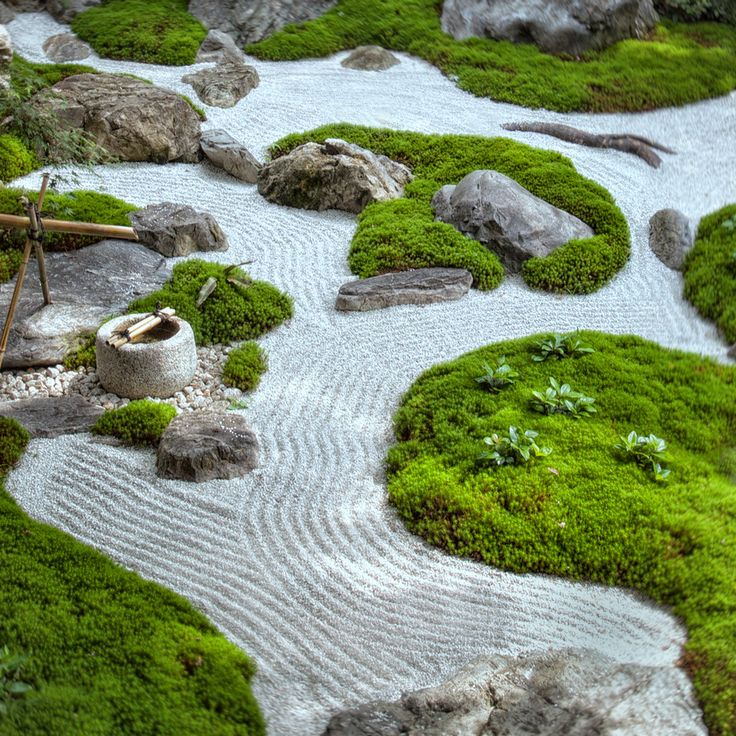 So, if you're ready to discover how to make your own backyard an oasis of calm, keep scrolling. These ideas are sure to have you inspired.
So, if you're ready to discover how to make your own backyard an oasis of calm, keep scrolling. These ideas are sure to have you inspired.
1. Create a stepping stone pathway
A curving path of stepping stones encourages a mindful wander through this plot
(Image credit: John Lander/Alamy Stock Photo/Alamy)
Every garden needs a path or two to get from the lawn to shed, or from the house to the gate. But pathways don't always have to be purely practical. When weaved around a small tree, a statue, or a body of water, they can also be used to encourage mindfulness.
Bring in some of our favorite stepping stone ideas and the effect is elevated further, as each step requires focus, and pace is automatically slowed. Opt for natural stone and keep lines curved, just like in this serene scene above. The result will allow you to journey around your plot in peace, taking in the surrounding nature and basking in the greenery of nearby foliage.
2.
 Surround a simple water feature with pebbles
Surround a simple water feature with pebblesA gently babbling water feature can add to the relaxing tone of a Zen garden
(Image credit: Amateur Gardening/Future)
The sound and sight of water is automatically soothing, which is why water feature ideas are a great addition to Zen gardens. However, don't be tempted by elaborate designs surrounded by vibrant pond plants. Instead, go simple, like this stunning stone design above.
Surrounded by smooth pebbles and then bordered in fine gravel, this sandy-hued style complements the landscape well. The babbling fountain provides a focal point which can be used to aid meditation, whilst offering a gentle soundscape. Be sure to position somewhere to sit nearby to take in the view.
Try adding a small acer or two nearby, too. It will bring a touch of color to the scene, whilst its gentle sway in the breeze will enhance the feelings of Zen.
3. Add an enchanting bridge
A bridge makes a beautiful feature, especially when placed beneath a stunning blossom tree
(Image credit: Digital-Fotofusion Gallery/Alamy Stock Photo/Alamy)
Bridges are a well-known addition to Japanese-style gardens, and work well in Zen gardens too.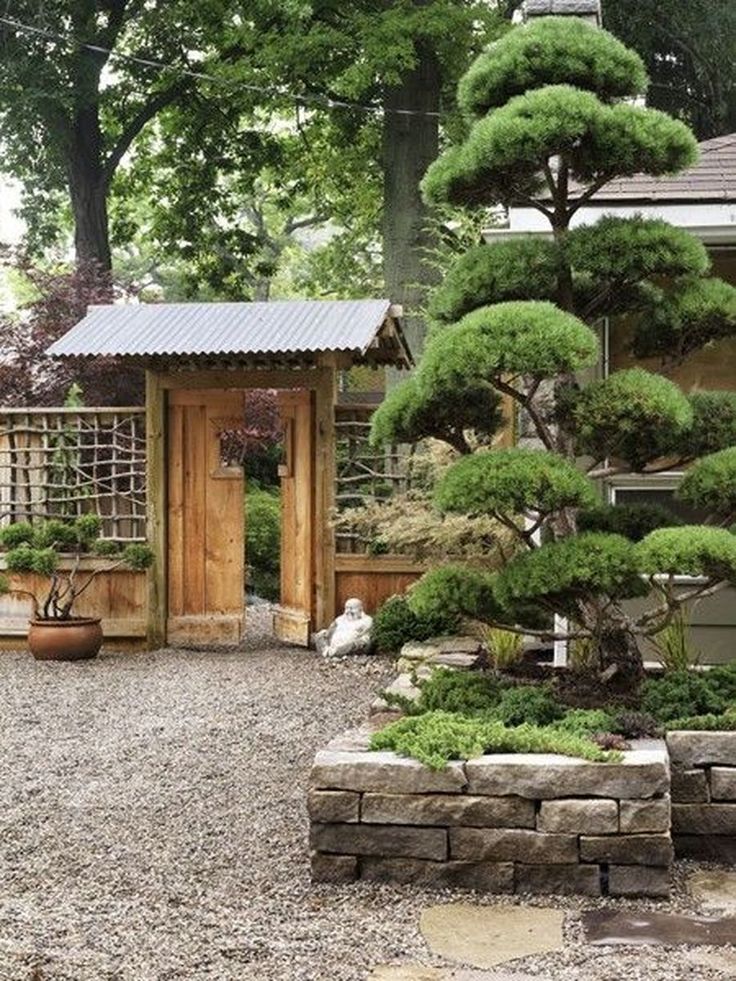 This isn't just because of their aesthetic value – bridges can also represent a journey of transition and encourage feelings of reflection.
This isn't just because of their aesthetic value – bridges can also represent a journey of transition and encourage feelings of reflection.
If you have a pond or even a small stream, a simple wooden structure like the one above is a lovely architectural feature. However, you don't have to have water to justify a bridge – symbolic features are commonplace in Zen gardens, so finely raked gravel, dry sand, or a pool of pebbles can be used to represent the flow of water instead. 'These are known as dry rivers,' says Garden Designer Lara Gochin Raffaelli of Enchanted Gardens. 'The placement of the dry river is important – it must be arranged to run from east to south to west, as this is the traditional Japanese positioning,' she adds.
A blossom tree is always a welcome addition to any garden, but works especially well in plots that are Japanese-inspired. As Lara says, '...a tree like a flowering cherry (Prunus) would be perfect for contemplating each of the four seasons: the stark, bare branches in winter; the beautiful blossoms in spring; the fresh green (or purple or burgundy or bronze) leaves in summer, and finally, the splendor of orange autumn leaves.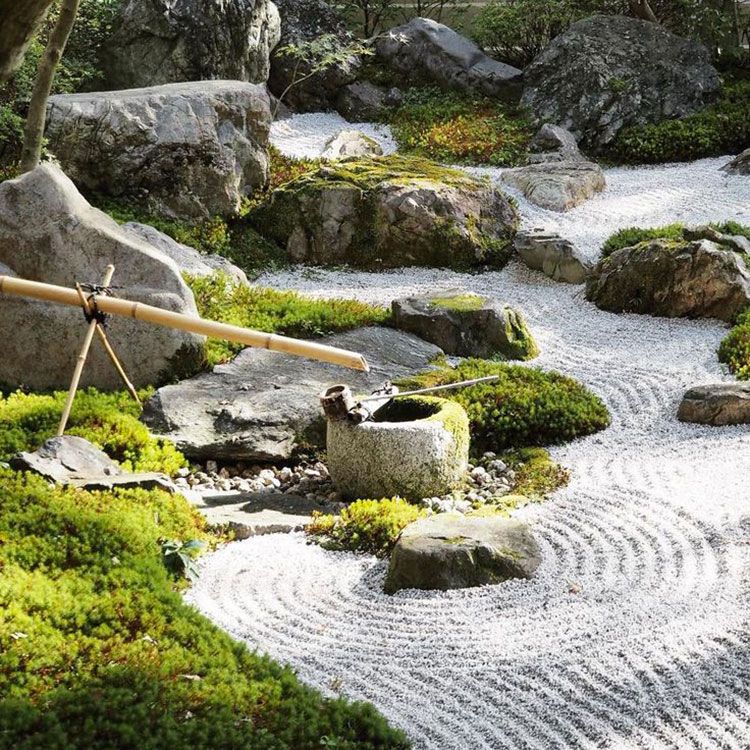 '
'
Take a look at our guide on the best flowering trees for some of our favorite picks.
4. Use large stretches of gravel
Fine gravel raked into patterns is a key feature of Zen gardens
(Image credit: Photick/ZenShui/Laurence Mouton/Photick/Getty Images Plus/Getty Images)
Fine gravel or sand is one of the most common features of Zen garden ideas, often selected in pale hues. It is known to symbolize water, and can be carefully raked into patterns to create 'waves'. Not only is the sight soothing, but the process of creating the patterns can be a meditative exercise in itself, as says Garden Designer Lara Gochin Raffaelli.
To recreate the authentic look, add a dedicated gravel area to your plot, perhaps with a border of larger rocks. A central tree, such as this impressive acer, can make a striking focal point and is a means to get creative with patterns. For instance, try a circular pattern around a tree's trunk, whilst the rest of the area can be raked into orderly straight lines for a gentle contrast.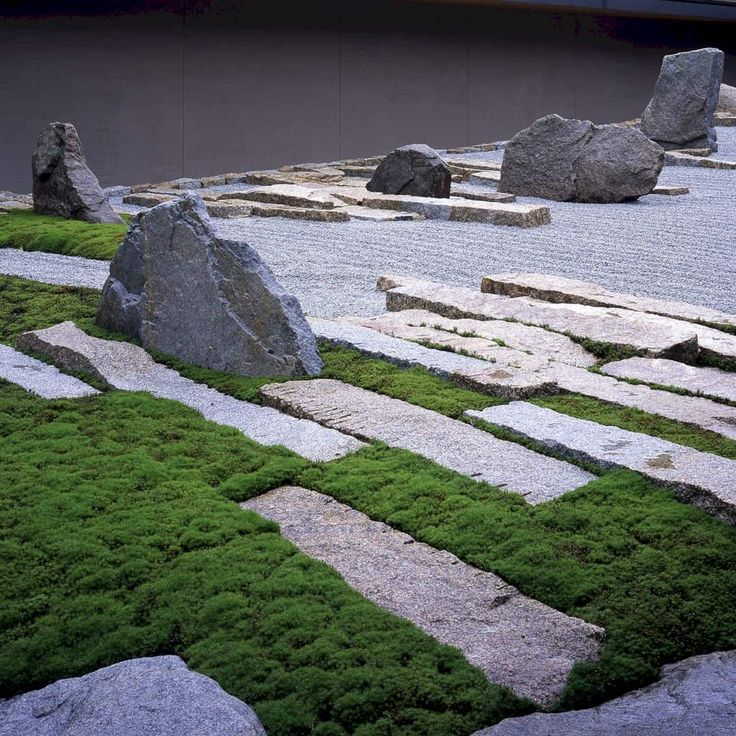
Looking for more ideas? Head over to our small rock garden ideas.
5. Choose different shades of stone
Two tones of gravel are used to create striking shapes in this garden
(Image credit: Apexphotos/The Image Bank Unreleased/Getty Images)
Everyone knows that getting out into nature is one of the most soothing things you can do, so it's no surprise that Zen gardens take inspiration from the natural landscape. As mentioned, this often crosses into the realms of symbolism, with features like rocks and moss representing larger parts of the natural world, such as mountains, islands, or forests.
So, as part of your Zen garden ideas, try positioning large stones and rocks as focal features in your plot. They will provide a sculptural element in a naturalistic way.
To take things one step further, opt for two tones of gravel and get creative with shapes. This example above could be interpreted as mountains jutting through clouds, or islands out at sea, but either way the result is spectacular.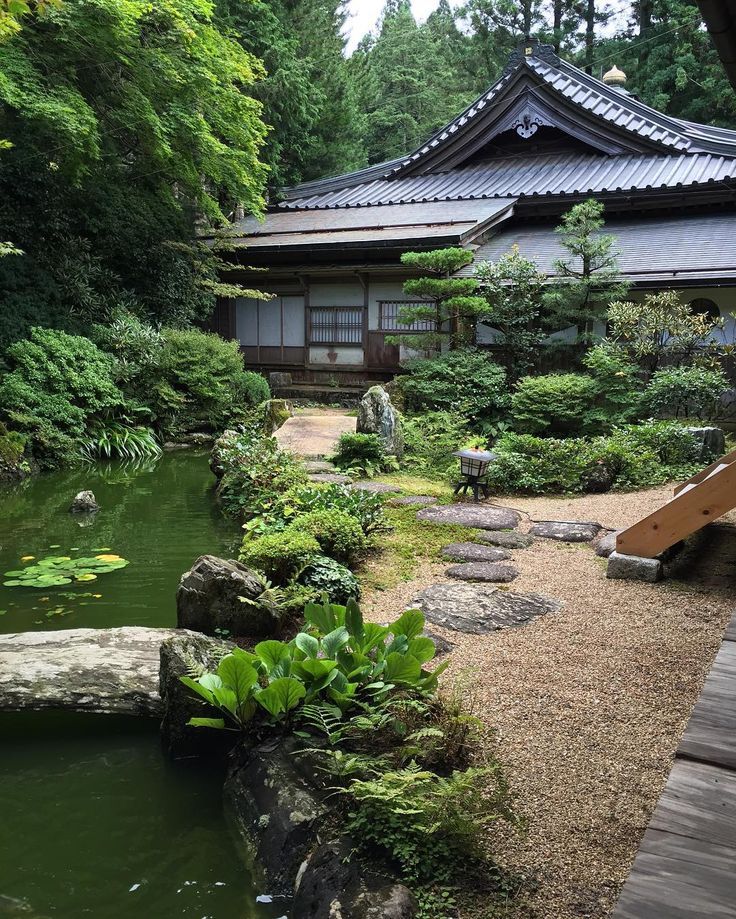 To keep things in place, surround your shapes with stone edging – our garden edging ideas feature is full of stunning styles.
To keep things in place, surround your shapes with stone edging – our garden edging ideas feature is full of stunning styles.
6. Curate small pockets of interest
Recreate aspects of the natural world using rocks, pebbles, and greenery
(Image credit: Aron Jungermann/Getty Images)
Another more simple way to create pockets of interest for your Zen garden ideas is to arrange miniature rockeries alongside your path, lawn, or gravelled space. Pick complementary tones and add a mixture of textures for visual appeal that mirrors the natural environment.
Ornamental grass can provide welcome height and break up the stretch of stone – learn how to grow ornamental grasses with our guide. Marcus Eyles, Horticultural Director of Dobbies Garden Centres suggests to try larger foliage types such as miscanthus and pampas grasses (cortaderia), or the blue Festuca glauca for ground cover. Try Japanese forest grass for shaded areas.
7. Opt for an archway
This Japanese-inspired garden, designed by Rhoda Maw Garden Design , is bound to turn heads
(Image credit: Rhoda Maw Garden Design)
If you're looking to add extra height and interest to your Zen garden ideas, then how about taking inspiration from this space, designed by Rhoda Maw Garden Design ? The Corten steel moon gate creates an enticing feature as it arches over a path, yet is elegantly pared-back.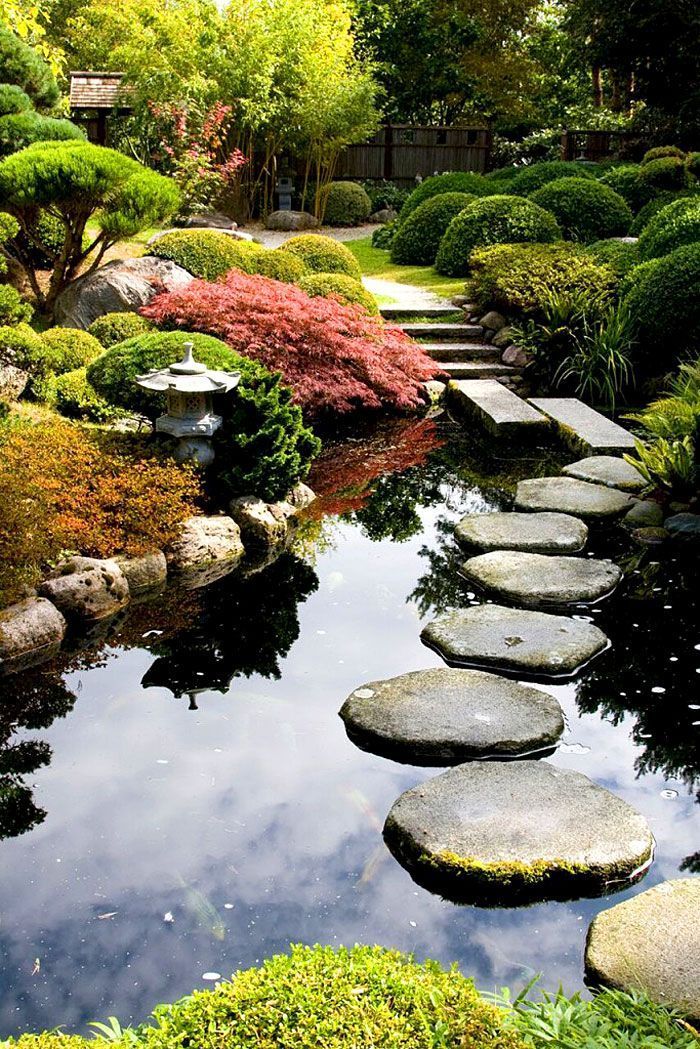
It's a lovely way to frame plants or other focal points in the garden, and works especially well for narrow plots when combined with a stepping stone path.
Take a look at our garden path ideas for more stunning designs.
8. Plant ferns amongst your rocks
Ferns add a soothing dose of green to a garden and evoke a woodland-like ambience
(Image credit: B.S.P.I./Corbis Documentary/Getty Images)
If you want to give your Zen garden ideas an old-world vibe, then learning how to grow ferns is a good place to start. They're a lovely way to soften hard textures and create a cooling, woodland feel. Marcus Eyles, Horticultural Director of Dobbies Garden Centres suggests opting for hardy evergreen types – including slow-growing tree ferns, hart's-tongue fern (Asplenium scolopendrium) and wood fern (dryopteris).
Plant amongst stone walls, or at the sides of borders to welcome their vibrant tones of green to your plot. They look especially striking amongst mossy areas – another classic choice for Japanese-inspired spaces.
9. Add soothing sounds with traditional features
A Shishi Odoshi is a traditional water feature with a soothing sound
(Image credit: Mark Scott/Future)
This water feature above is known as a Shishi Odoshi, which are traditionally seen in Japanese gardens. Made from bamboo, they create a soothing, periodic noise which, although originally meant to deter deer, can be rather appealing.
They make a good addition to Zen garden ideas, especially when surrounded by an array of flat stones and rocks, as seen here. For more peaceful accents to your plot, take a look at our sensory garden ideas.
10. Go for curved edges for your Zen garden ideas
Clip your evergreens into soft, curved shapes
(Image credit: Caroline De Vries/Getty Images)
Zen garden ideas benefit from soothing shapes, so when thinking about the landscaping of your plot, welcome in curves. This can be from your lawn and paths to the lines raked in your gravel, but also consider trying your hand at topiary.
Evergreen azaleas and other shrubs (and even trees) can be clipped into soft, round, cloud-like shapes, for a soothing scene. This is a traditional approach in many Japanese gardens, and is known as Niwaki. It's not too tricky to recreate either, all you need is your best garden shears and a bit of practice.
Take a look at our small Japanese garden ideas for more inspiration.
11. Bring color to the scene with acers
Bright red acer trees will always steal the show come autumn
(Image credit: Masako Ishida/Moment Unreleased/Getty Images)
Although Zen garden ideas tend to stick to simple palettes of natural stones and green foliage, a well-considered pop of color here and there can add a pleasing touch. This is especially the case when it comes from the Japanese garden staple – an acer tree.
Available in tons of varieties and sizes, these leafy beauties sport show-stopping tones in autumn, such as this fiery red. Paired against minimal backdrops and stark rock formations, they can look spectacular.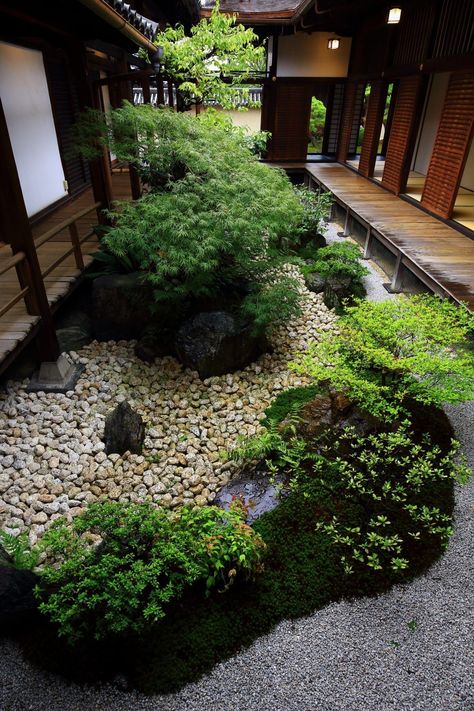
Learn how to grow acers for year-round interest in your garden with our guide.
What are the best plants for Zen gardens?
Tucked-away stairs amongst neatly-shaped shrubs add a sense of intrigue to this scene
(Image credit: Krzysztof Baranowski/Moment Open/Getty Images)
Lara Gochin Raffaelli, Garden Designer from Enchanted Gardens, shares her suggestions for the best plants for Zen gardens.
Choose some plants that are evergreen for year-round interest and structure, she says. Think bamboo (make sure to select the non-invasive type), conifers, Liriope muscari, Pachysandra terminalis, grasses, or even semi-evergreen ferns.
Lara also recommends to pick plants which will provide interest in different seasons. For instance, Prunus 'Kanzan' will provide pretty pink blossoms in spring, but also striking yellow-orange foliage in autumn. Acer palmatum is another choice for autumn interest, with its red-orange leaves. White hydrangeas make a stunning accent throughout the summer months – our guide on how to grow hydrangeas is full of useful tips.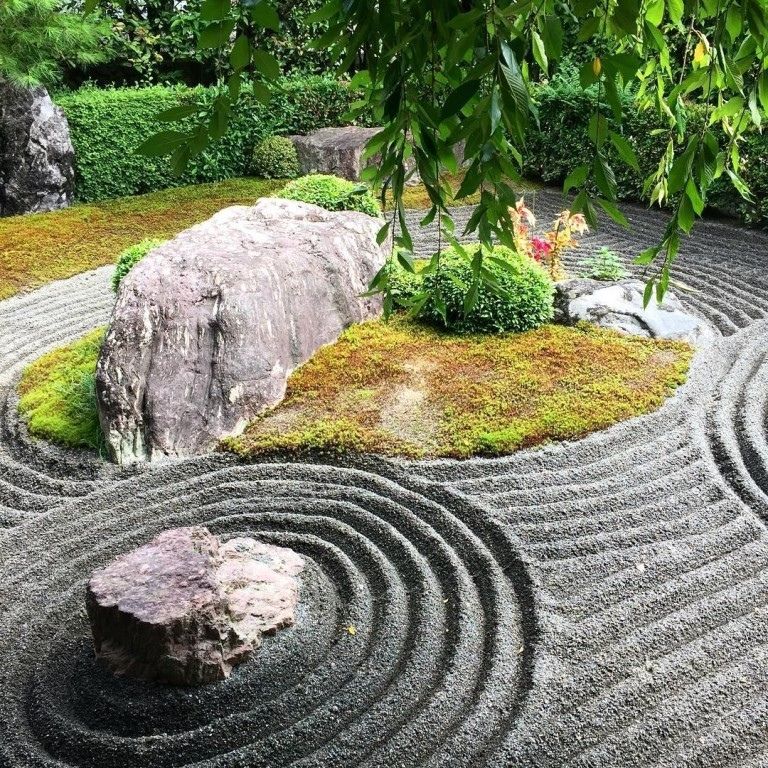
The garden was always a big part of Holly's life growing up, as was the surrounding New Forest where she lived. Her appreciation for the great outdoors has only grown since then. She's been an allotment keeper, a professional gardener, and a botanical illustrator – plants are her passion.
Zen gardens in residential architecture: an unobvious solution
There is an opinion that Japanese gardens are the pinnacle of landscape architecture. Their mission is to recreate the beautiful corners of nature in miniature. If fountains, topiaries, art objects and MAFs are quite often used in modern residential complexes, then zen gardens remain a rarity, although they have a number of advantages. We propose to turn to examples of the classical and modern approach to the organization of Japanese gardens in order to transform these ideas into the space of a new progressive residential complex.
Traditional Zen: Ryoan-ji and Koraku-en
Japanese culture and religion regard nature as the embodiment of Supreme Harmony.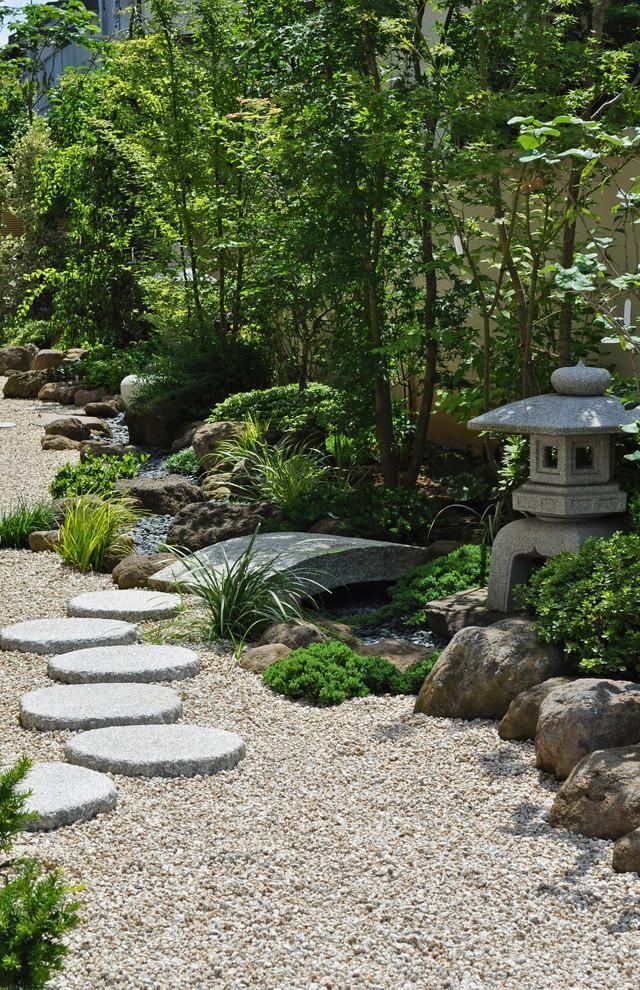 "Zen" means "to be in contemplation", so the philosophy of the garden is to dissolve in nature and forget about the unpleasant for a while, calm down, hear yourself.
"Zen" means "to be in contemplation", so the philosophy of the garden is to dissolve in nature and forget about the unpleasant for a while, calm down, hear yourself.
The most famous rock garden in the world is located in Ryoan-ji Monastery (Kyoto, Japan). A flat area of small size strewn with white gravel. There are fifteen stones on it. The uniqueness of the garden is that from any vantage point you will see only fourteen stones, one will always remain invisible to the eye.
Ryoan-ji Monastery Rock Garden, Kyoto, Japan. Photo: id.zekkeijapan.comAnother example of a classic Japanese garden is Koraku-en Park in the city of Okayama on the island of Honshu in Japan. This famous park has been known since 1871. It occupies 13 hectares and perfectly demonstrates the techniques and elements traditional for Zen gardens: a lot of air, water, stone, dwarf trees. The landscape is “drawn” in the most natural calm shades.
Koraku-en Park, Fr. Honshu, Japan. Photo: fotostrana.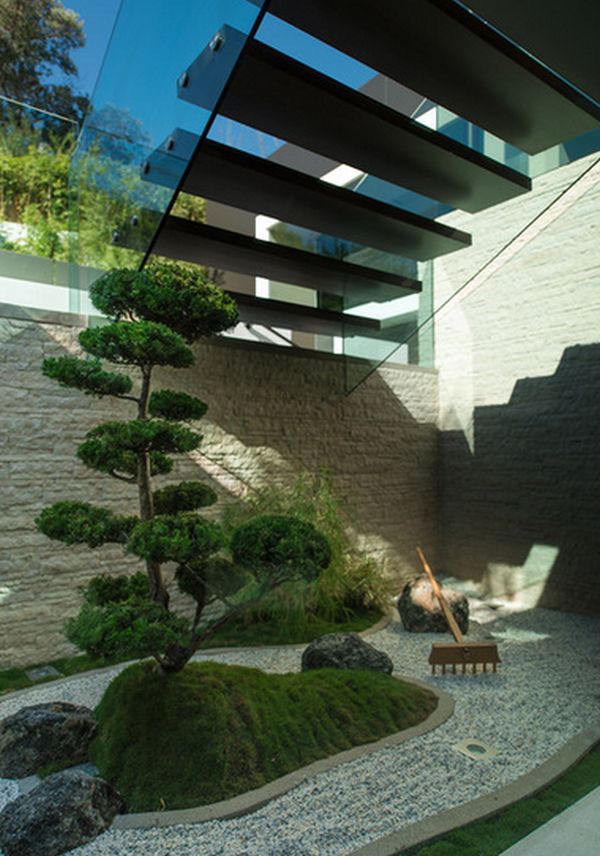 ru
ru Modern Zen: Austin Nichols House in New York
Austin Nichols House was built in 1915 as a grocery store and then changed its purpose several times. Today it has completely changed, turning into an island with a measured rhythm of life among the “never sleeping” metropolis. The traditional motifs and philosophy of the Japanese garden were transformed here into a modern context and, despite the free interpretation, were accurately transferred to the concept of the complex's landscaping.
Austin Nichols House is located in the prestigious area of New York - Williamsburg. This is one of the famous buildings on the Brooklyn waterfront, overlooking the Manhattan skyline. The tranquil open area even includes the North Williamsburg Ferry Terminal. Residents of the home enjoy a waterfront gym, children's playroom, landscaped courtyard and roof terrace, residents' living room with kitchen, co-working space, movie theater, music rehearsal room, and zen garden with fire pit and garage.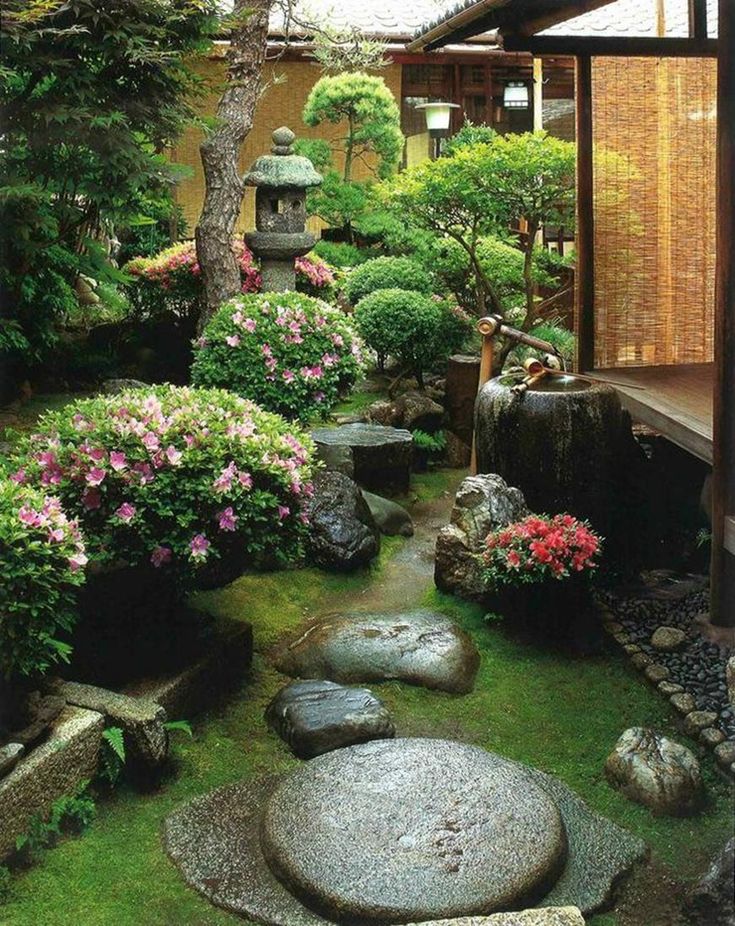 Such a friendly and comfortable local area is unusual even for New York.
Such a friendly and comfortable local area is unusual even for New York.
Philosophy according to the rules
Conditions for creating a landscape mini-park: naturalness, asymmetry and the presence of free space, which should emphasize the purity of forms. A Zen garden should have a "protagonist" around which the composition is built - stone, water, tree or moss. In "dry gardens", water is replaced with pebbles or sand, which gave rise to the name "rock garden". For decoration, designers use evergreen shrubs, dwarf trees and flowers. Traditionally, these are azalea, pine, ferns, irises, palm-shaped maple.
Mandatory element - stones of different sizes and shapes. Gravel, boulders and moss are much easier to care for than living plantings, and carry a deep philosophical meaning. Gravel and stones mean stability and order, sand and pebbles play the role of water: carefully raked sand with patterns of waves or circles on the water should encourage reflection on the flow of life - sometimes calm, sometimes stormy, like a waterfall. Stone lanterns or "pagoda lights" are an artistic accent and a source of light that creates an atmosphere of mysterious twilight.
Stone lanterns or "pagoda lights" are an artistic accent and a source of light that creates an atmosphere of mysterious twilight.
The Japanese garden consists of natural colors and shades: gray, brown, green. Blotches of red can only emphasize the overall tone.
To connect paths of different levels, wooden and stone bridges are used, the main condition for the creation of which is natural materials. Arched red bridges originally from China often rise above rocks and plants. Another possible decorative element is the gate (torii), which stands at the border of the garden and serves as a symbol of welcome and hospitality for new guests.
Brooklyn Botanical Garden, New York (USA). Photo: traveltimes.ruPitfalls of Japanese gardens
Despite its apparent simplicity, the creation of a Japanese garden is quite an expensive undertaking.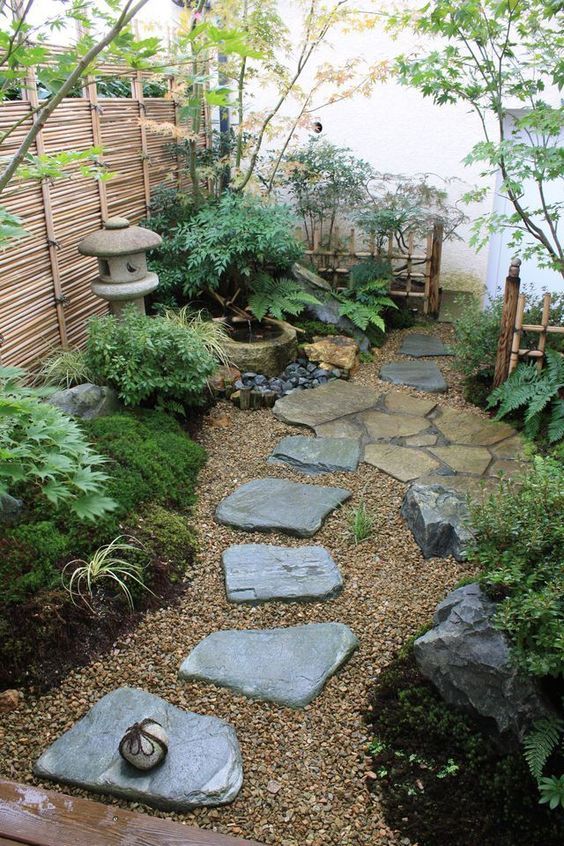 In Zen gardens, a large amount of natural material is used, the placement of stones and boulders should take place in certain places. In addition, a separate line in the estimate is occupied by garden bonsai-niwaks from various species of pine, spindle tree, laying the foundation of the garden.
In Zen gardens, a large amount of natural material is used, the placement of stones and boulders should take place in certain places. In addition, a separate line in the estimate is occupied by garden bonsai-niwaks from various species of pine, spindle tree, laying the foundation of the garden.
Zen gardens are a rare style in modern landscape design. Such gardens are part of the culture, and the owner of the house should be an adherent of it. Sitting on a stone and contemplating the surrounding space, a person plunges into the world of thoughts, pondering his life in the silence of the park or tuning in a certain way. In addition, caring for plants requires special skills.
Vadim Sokolov, landscape architect at Art Green Design studio (Moscow)
Most developers are not familiar with the phrase "zen garden" at all. More often they are interested in budget projects. Such gardens require competent design and the same implementation, which costs a lot of money at all stages.
Lyubov Begma, landscape designer at Natalis (Kyiv, Ukraine)Even when a design company develops a free sketch and wins the tender, the budget is cut and is not enough for quality work. Plus, the state of the places allocated for landing always leaves much to be desired. Not all developers agree to the irrigation system, as well as to the subsequent maintenance.
Life in Zen style
Despite the difficulties in creating Japanese islands of calm, developers should pay attention to this technique. A symbol of balance and peace, the "dry garden" gives the room and territory of the house conciseness and the absence of visual noise. Zen miniatures of various sizes and shapes emphasize the concept of the residential complex, making it stand out from the competition. A free interpretation of classical decorative forms is allowed, a garden can be large or small, but what is invariable: minimalism captivates with restraint and depth.
The main advantage of a Zen garden is flexibility.
It can be adapted to any climate and the most varied sizes of plots, while constantly transforming at will or depending on the season and
. The discreet landscape will contrast with the noisy children's and sports grounds and will perfectly complement the corner of the yard in which the developer is designing a meeting space for neighbors or a promenade.
The main factors that are taken into account are the area of the site, the terrain, elevation changes, the thickness of the soil layer (friability and chemical composition of the soil) and the frost resistance of plants, which is especially important for Russia.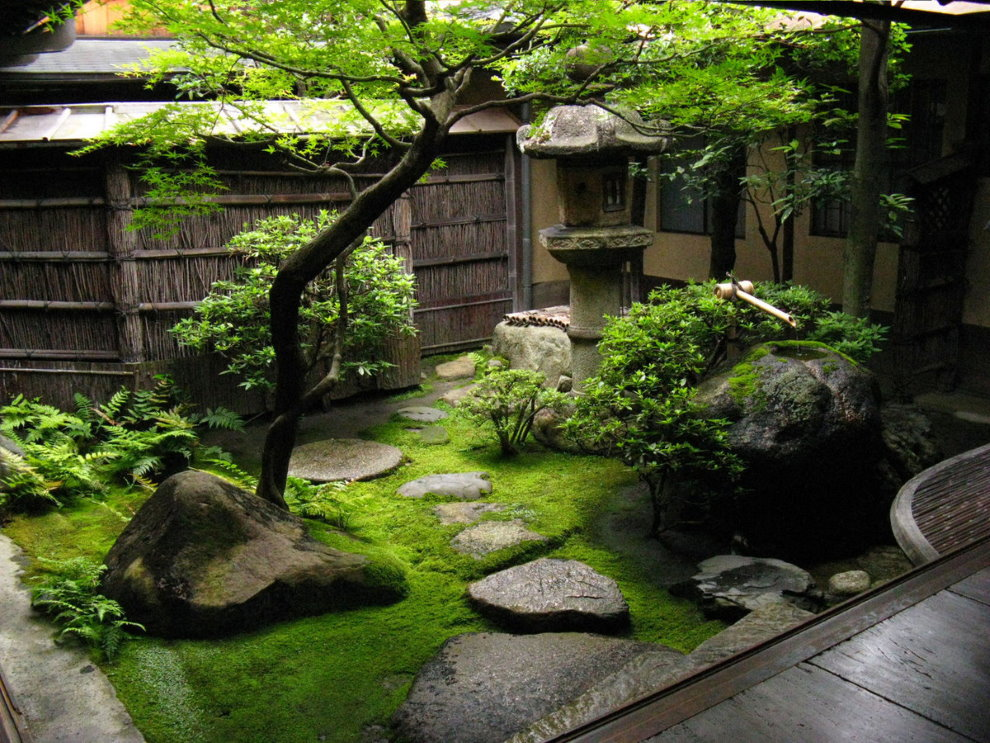 Plants on the territory can be planted not in the ground, but in flowerpots - it is easier to move and clean them indoors for a period of severe cold. Using the same materials, it is possible to create an infinite number of compositions. No two zen gardens are the same in the world.
Plants on the territory can be planted not in the ground, but in flowerpots - it is easier to move and clean them indoors for a period of severe cold. Using the same materials, it is possible to create an infinite number of compositions. No two zen gardens are the same in the world.
Miniature versions of Japanese rock gardens will look great at the entrance, on the terrace, in front of the entrance group and at the entrance to the territory. A stylized flower bed can occupy a niche or stretch along the walls.
Residence in Kurakuen / Office of NRM-Architects. Photo: ArchDaily In Russia, the trend for zen gardens is only gaining momentum. By 2023, in the south-west of Moscow, the construction of the EVER business class quarter, in which architects and designers have combined the buildings with a stylobate with a Japanese garden on the roof, should be completed. And so far, this is one of the few examples of local integration of the “dry garden” into the space of modern residential architecture.
In the post-pandemic world, the home has become a place of remote work for many, and people have become especially in dire need of places to “reset”. The rock garden has a calming effect and allows you to get off the emotional swing. Therefore, the techniques of Japanese landscape art will be new motives to return to modern landscaping.
Text: Olga Novikova
How to equip a real Japanese Zen garden on a loggia?
The Japanese Garden is a historically accepted area for relaxing, discovering your Zen and seeking harmony. If you decide to equip yourself with the same one, it is worth considering the concept of the entire composition in advance, and it will not be superfluous to study the issue, read the literature.
Well, we will tell you how to approach the creation process from a purely functional point of view: what materials to use, what to consider and how to implement.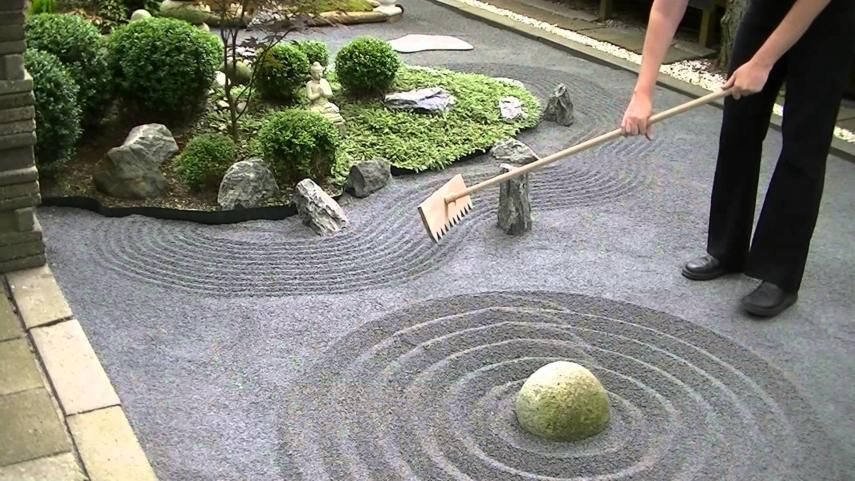
Japanese garden is the edge of harmony and reality
Therefore, it is important to provide some kind of barrier to your home garden from the rest of the world. It is very successful if you have a glazed balcony or loggia, although you can come up with something unique with open space.
The barrier will be either a finishing material or plants from your garden, or you can combine both options. Your task is to build a harmonious wall, put up a hedge to calve from the outside world, but not be completely closed from it.
Alternatively, you can decorate the wall of the loggia or balcony with rattan, build a suitable frame and plant climbing plants. In general, vertical plantings will not be superfluous for arranging a Japanese garden, but choose the right plants - bamboo, loaches, palm trees, dried flowers, etc.
Stones or sand
The Japanese garden can serve as an anti-stress garden. You have probably seen small compositions with mini rakes and sand, which they sort out in every possible way with these same rakes and instantly catch zen.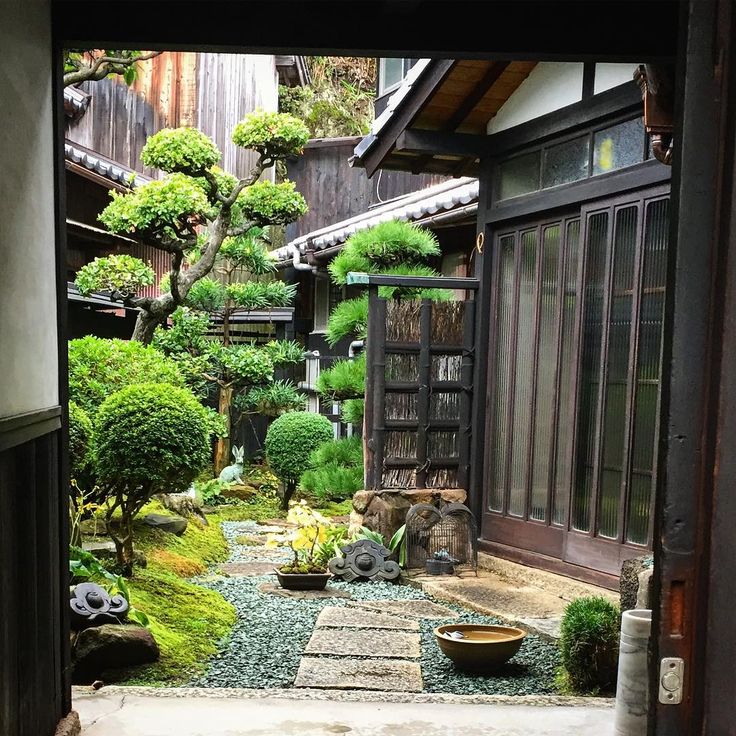 Arrange this on the loggia.
Arrange this on the loggia.
For example, you can equip a small area with such sand, and the rest of the space is covered with stones. It's called the rock garden.
In general, smooth pebbles in such a garden of peace are the most necessary attribute that will remind you of Japan and their Zen teachings. You can lay the entire pier or the borders of the paths with stones, or you can simply decorate some elements - large planters with plants, etc.
Wood and tiered elements, fountain
The decorative aspect of the Japanese garden is also important! The desired aesthetic can be arranged if you follow the canons of the Japanese style.
To do this, use natural wood, or even better - stacked bamboo stalks. Wooden terrace tiles or boards will look spectacular on the floor. If the parameters of the loggia allow, you can equip a multi-level floor.
To do this, a hidden frame is built for the future floor, then pebbles or sand are poured onto the ceiling.